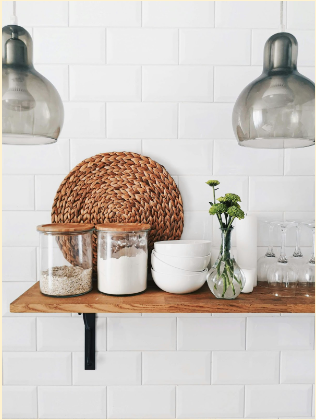Say goodbye to chaos and hello to peace with these organization tips.

In the bustling life of a modern family, an organized home serves as a sanctuary of peace. Cluttered spaces not only strain the eyes but also the mind, leading to unnecessary stress and chaos. On the other hand, an organized home helps maintain the smooth flow of your family’s daily life. As you and your family gear up for the busy summer season, giving your home—and your finances—a little bit of love will go a long way. Let’s talk through the principles of home organization, decluttering techniques, innovative storage solutions, and much more, aiming to transform your living space and your finances into havens of calm and order.
Clutter and Its Impact On Your Home
As mentioned before, clutter is more than just an eyesore. It’s a pervasive element that can negatively affect your family’s mental wellbeing. Studies show that cluttered environments lead to heightened stress levels, reduced focus, and a general overwhelming sense. The psychological burden of clutter can impede your family’s ability to relax and enjoy time together.
Organizing as a Family
Organizing the clutter of your home is not solely the responsibility of one person. Instead, make it a family affair. Involving every member, including your children, in the organization process not only lightens the load but also instills a sense of ownership toward maintaining the order in your home.
Here are a few tips to make organizing your home a family activity:
- Set goals – Discuss what each person hopes to achieve with your organization efforts. Setting common goals ensures everyone is on the same page.
- Assign roles – Depending on the age and ability of everyone in your family, assign specific tasks to each family member. It could range from sorting toys to filing paperwork. This way, everyone understands what’s expected of them.
- Have fun with it – Let’s face it—organizing is boring. But it doesn’t always have to be! Incorporate games and rewards for completed tasks. This helps get everyone excited to be involved, especially the younger kiddos.
By fostering a collaborative environment, organizing becomes less of a chore and more of a bonding activity.
Room–By-Room Organization Strategies

Living Room
For many of us, our living room is the epicenter of our home where our family often gathers. And, because of that, living rooms tend to bear the brunt of daily clutter. To keep this communal space welcome and functional, try the following strategies:
- Declutter regularly – Begin with a thorough decluttering session. Remove any times that don’t belong in the living room, such as toys, dishes, or paperwork.
- Find creative storage solutions – Invest in multifunctional furniture with built-in storage, like ottomans or couches with hidden compartments. Use shelves and baskets for books, remotes, and decorative items to reduce surface clutter.
- Create zones – Define specific areas within the room for your activities, like playing games, reading, or crafting. This helps in maintaining order and allocating your storage space adequately.
Kids’ Rooms
Children’s rooms are dynamic spaces and have their own unique sets of needs organizationally. While you may need to be flexible with how you approach decluttering your child’s space, here are some tips to help you get started:
- Rotate your toys – Use bins to rotate toys, keeping only a portion accessible at any time. Not only will this help you reduce clutter, but it will also keep your kid’s interest in toys fresh.
- Find a system to organize clothes – Install lower rods in closets for easy access and encourage your child to take on the task of organizing their things on their own. Use drawer dividers for smaller items like socks and underwear.
- Designate a place for educational materials – Create a dedicated study area with containers or shelves for school books and supplies. Encourage your children to tidy up this area after homework time.
Kitchen and Dining Areas
The kitchen is the home’s hub, requiring efficient organization to handle meal preparation and family gatherings smoothly.
- Manage your pantry – Use clear bins or baskets to group pantry items by category (snacks, baking ingredients, canned goods). Label shelves for quick access and inventory management.
- Find a system for storing appliances and tools – Assign drawers and cabinets for specific items, keeping frequently used tools within reach. Consider hanging pots and pans to save cabinet space.
- Declutter your countertops – Keep countertops clear except for essential appliances. Use wall-mounted holders for utensils and spices to maximize space.
Decluttering Techniques
Moving forward in our guide, let’s explore some effective decluttering techniques that can help streamline the organization process throughout your home. These methods are not only about getting rid of excess items but also about instilling a sense of order and peace in your living spaces.
The Four-Box Method
This straightforward yet powerful system can drastically simplify the decluttering process. It involves four boxes (or areas) labeled: Keep, Donate, Store, and Throw Away. Here’s how to use it:
- Keep: Items that are regularly used, loved, or have significant value.
- Donate: Items in good condition that are no longer needed or used.
- Store: Seasonal items, keepsakes, or things not currently in use but needed later.
- Throw Away: Broken, outdated, or unusable items that can’t be donated or sold.
By systematically sorting items into these categories, you can make quick decisions and significantly reduce clutter. It’s a method that works well in any room and can be a great activity for the whole family to participate in.
The KonMari Method
Developed by Marie Kondo, this method focuses on keeping only those items that “spark joy.” While it can be more time-consuming, its thoroughness can lead to a more profound organizational transformation. The key principles include:
- Categories, not rooms: Organize items by category (clothes, books, papers, etc.) rather than by room. This approach helps you see the full extent of what you have and make more deliberate decisions about what to keep.
- Spark joy: Hold each item to decide if it sparks joy. If it does, keep it; if not, thank it for its service and part with it.
- Designate a place: Every item you choose to keep should have a designated place within your home.
These decluttering techniques are not mutually exclusive and can be adapted or combined to suit your family’s needs and preferences. By reducing clutter, you not only free up physical space but also clear mental space, leading to a more serene home environment.
Home Storage Solutions and Organizational Tools

In homes, especially those with limited space, creativity is key to finding new storage solutions. Here are some ideas to inspire your organizational efforts:
- Make use of vertical space – Utilize walls with shelving units, hanging organizers, or hooks to store items off the floor and countertops. Vertical space is often underused and can be a game-changer for storing books, toys, kitchen tools, and more.
- Take advantage of under-bed storage – Use drawers, bins, or vacuum-sealed bags to store seasonal clothing, linens, or rarely used items under beds. This not only clears clutter but also keeps items dust-free and out of sight.
- Find hidden storage opportunities – Look for unexpected places to add storage, such as over doors, inside cabinet doors, or even in the gaps next to appliances. Small shelves or organizers in these spots can hold extra supplies or tools.
Organizing Financial Documents

As we near the conclusion of our ultimate guide to organizing your family home, we focus on a crucial aspect often overlooked: financial organization and planning. A well-organized financial document system is pivotal for managing your family’s finances efficiently. It reduces stress during tax season, aids in budgeting, and is indispensable during unforeseen events requiring quick access to financial information.
- Categorize documents – Sort financial documents into categories such as bank statements, investment records, loan documents, and insurance policies. This simplification can save you time and confusion when specific documents are needed.
- Use a filing system – Whether you prefer a digital system, a physical file cabinet, or both, maintaining a consistent filing system is key. For digital files, use encrypted storage and back up important documents to protect against data loss.
- Review your documents regularly – Schedule time to review and purge outdated documents annually. This not only keeps your financial records up to date but also reduces unnecessary clutter.
Keep Your Estate Plan Updated
Estate planning, including wills and trusts, is another critical element of your family’s financial organization. It ensures that your assets are distributed according to your wishes and can provide for guardianship arrangements for minor children.
Your estate plan should include:
- A will – This fundamental document outlines how you wish your assets to be distributed among beneficiaries and can designate guardians for any minor children. It’s crucial to update your will following significant life events such as marriage, divorce, the birth of a child, or the acquisition of significant assets to ensure it reflects your current wishes.
- Trusts – Trusts can be used for various purposes, including avoiding probate, managing taxes, and specifying conditions under which assets are distributed to beneficiaries. There are different types of trusts for different needs, such as revocable living trusts, which can be altered during your lifetime, and irrevocable trusts, which cannot be changed once established.
- Life insurance policy – Life insurance provides financial protection for your dependents, offering them a secure source of income in the event of your untimely death. It’s a critical component of your estate plan, especially if you have young children or significant debt that might otherwise burden your estate. Instant life insurance distinguishes itself by offering a quick application process, often with immediate approval decisions and no medical exam required. Ensure your policy is updated to accurately reflect your current family structure and financial obligations.
Keeping your estate plan updated requires periodic reviews and, possibly, modifications to reflect new laws, changes in your financial situation, or shifts in your personal relationships. It’s recommended to review your estate plan at least every three to five years or after any major life event. Consulting with a financial advisor or estate planning attorney can provide you with guidance tailored to your specific situation and ensure your estate plan remains aligned with your goals.
In wrapping up our comprehensive guide to organizing your family home, we’ve journeyed through decluttering your living spaces, engaging the whole family in organizational activities, and securing your family’s financial future. This guide not only aimed to transform cluttered rooms into havens of peace but also emphasized the importance of financial foresight in estate planning. Remember, organizing your home extends beyond mere physical tidiness; it’s about creating a cohesive, serene environment that supports and nurtures your family’s well-being and future security. By taking incremental steps toward organizing both your physical space and your financial affairs, you pave the way for a more organized, peaceful, and prosperous life for you and your loved ones.

Leave a Reply